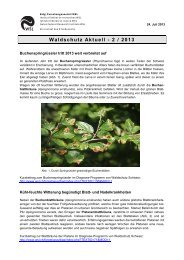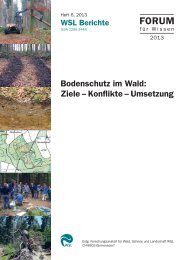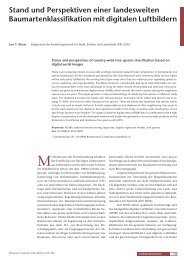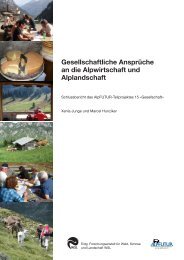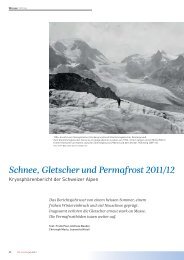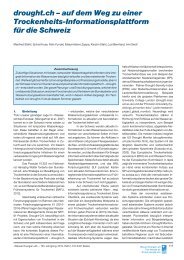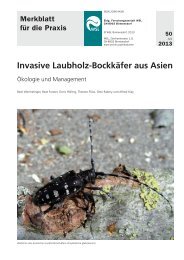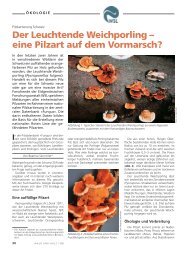Ecology and management of the spruce bark beetle Ips ... - WSL
Ecology and management of the spruce bark beetle Ips ... - WSL
Ecology and management of the spruce bark beetle Ips ... - WSL
You also want an ePaper? Increase the reach of your titles
YUMPU automatically turns print PDFs into web optimized ePapers that Google loves.
78<br />
control measures will guide silvicultural practices to<br />
sustain <strong>and</strong> increase <strong>the</strong> regulatory capacities <strong>of</strong> natural<br />
enemies.<br />
In <strong>the</strong> long run, <strong>the</strong> most reliable <strong>and</strong> ecologically<br />
sound strategy to confine outbreaks <strong>of</strong> I. typographus<br />
will involve habitat <strong>management</strong>, i.e. silvicultural<br />
adaptations. The key question is how to reduce <strong>the</strong><br />
susceptibility <strong>of</strong> forests <strong>and</strong> <strong>spruce</strong> trees. One way to<br />
reduce <strong>the</strong> susceptibility <strong>of</strong> a forest is to transform<br />
uniform <strong>spruce</strong> st<strong>and</strong>s into more diverse ecosystems.<br />
Forests with highly diverse tree composition, age<br />
structure, <strong>and</strong> ground vegetation have a different tree<br />
physiology <strong>and</strong> are more resistant to windthrow <strong>and</strong><br />
<strong>bark</strong> <strong>beetle</strong> attack (cf. Jactel et al., in press). Where<br />
pure <strong>spruce</strong> forests are to be maintained for economic<br />
reasons, factors affecting tree <strong>and</strong> st<strong>and</strong> susceptibility<br />
will have to be considered. The physiological state <strong>of</strong><br />
potential host trees <strong>and</strong> <strong>of</strong> course, <strong>the</strong> wea<strong>the</strong>r is<br />
crucial for a successful attack by I. typographus <strong>and</strong><br />
for <strong>the</strong> dynamics <strong>of</strong> an outbreak. Many <strong>of</strong> <strong>the</strong> key<br />
factors are difficult or even impossible to manage, e.g.<br />
altitude, soil nutrients, tree growth characteristics, <strong>and</strong><br />
resin production. O<strong>the</strong>rs, such as st<strong>and</strong> age, fungal<br />
infection risk, or tree provenances, are more readily<br />
manageable through silvicultural practices. However,<br />
non-autochthonous <strong>spruce</strong> st<strong>and</strong>s will always be prone<br />
to <strong>bark</strong> <strong>beetle</strong> infestations, even more so as global<br />
change is very likely to alter <strong>the</strong> tree/<strong>bark</strong> <strong>beetle</strong><br />
system. How changes in temperature, precipitation<br />
<strong>and</strong> wind regimes will affect <strong>the</strong> individual host tree,<br />
<strong>the</strong> st<strong>and</strong>, <strong>the</strong> <strong>spruce</strong> <strong>bark</strong> <strong>beetle</strong>s <strong>and</strong> <strong>the</strong>ir natural<br />
enemies is open to speculation. It would be worthwhile<br />
to model in an explorative way various scenarios<br />
<strong>of</strong> this complex system, so as to be better prepared for<br />
managing <strong>bark</strong> <strong>beetle</strong> outbreaks in <strong>the</strong> future.<br />
Acknowledgments<br />
I thank J. Bucher, B. Forster, R. Gall, <strong>and</strong> two<br />
anonymous reviewers for valuable comments on earlier<br />
versions <strong>of</strong> <strong>the</strong> manuscript. Silvia Dingwall kindly<br />
checked <strong>the</strong> English writing.<br />
References<br />
Abgrall, J.F., Juvy, B., 1993. Incidence de la température sur le<br />
développement du Typographe, <strong>Ips</strong> typographus L. (Coleoptère,<br />
B. Wermelinger / Forest <strong>Ecology</strong> <strong>and</strong> Management 202 (2004) 67–82<br />
Scolytidae) en zones montagneuses. Inform. Techn. CEMA-<br />
GREF 90, 1–7.<br />
Anderbrant, O., 1990. Gallery construction <strong>and</strong> oviposition <strong>of</strong> <strong>the</strong><br />
<strong>bark</strong> <strong>beetle</strong> <strong>Ips</strong> typographus (Coleoptera: Scolytidae) at different<br />
breeding densities. Ecol. Entomol. 15, 1–8.<br />
Aukema, B.H., Dahlsten, D.L., Raffa, K.F., 2000. Exploiting behavioral<br />
disparities among predators <strong>and</strong> prey to selectively<br />
remove pests: maximizing <strong>the</strong> ratio <strong>of</strong> <strong>bark</strong> <strong>beetle</strong>s to predators<br />
removed during semiochemically based trap-out. Environ. Entomol.<br />
29, 651–660.<br />
Baier, P., 1996a. Auswirkungen von Vitalitaät und Brutbaum-Qualität<br />
der Europäischen Fichte, Picea abies, auf die Entwicklung<br />
der Borkenkäfer-Art <strong>Ips</strong> typographus (Coleoptera: Scolytidae).<br />
Entomol. Gener. 21, 27–35.<br />
Baier, P., 1996b. Defence reactions <strong>of</strong> Norway <strong>spruce</strong> (Picea abies<br />
Karst) to controlled attacks <strong>of</strong> <strong>Ips</strong> typographus (L.) (Col Scolytidae)<br />
in relation to tree parameters. J. Appl. Entomol. 120,<br />
587–593.<br />
Baier, P., Führer, E., Kirisits, T., Rosner, S., 2002. Defence reactions<br />
<strong>of</strong> Norway <strong>spruce</strong> against <strong>bark</strong> <strong>beetle</strong>s <strong>and</strong> <strong>the</strong> associated fungus<br />
Ceratocystis polonica in secondary pure <strong>and</strong> mixed species<br />
st<strong>and</strong>s. For. Ecol. Manag. 159, 73–86.<br />
Bakke, A., 1992. Monitoring <strong>bark</strong> <strong>beetle</strong> populations: effects <strong>of</strong><br />
temperature. J. Appl. Entomol. 114, 208–211.<br />
Bakke, A., Kvamme, T., 1981. Kairomone response in Thanasimus<br />
predators to pheromone components <strong>of</strong> <strong>Ips</strong> typographus. J.<br />
Chem. Ecol. 7, 305–312.<br />
Becker, T., 1999. Zunehmender Borkenkäferbefall in zwei fichtenreichen<br />
Bannwäldern Baden-Württembergs. In: Wulf, A.,<br />
Berendes, K.H., (Eds.), Forstschutzprobleme in Nationalparken<br />
und Naturschutzgebieten. Mitt. Biol. Bundesanst. L<strong>and</strong>- Forstw.,<br />
Berlin, vol. 362, 80–100.<br />
Becker, T., Schröter, H., 2000. Ausbreitung von rindenbrütenden<br />
Borkenkäfern nach Sturmschäden. Allg. Forstztg. 55, 280–282.<br />
Bombosch, S., Dedek, W., 1994. Integrierter Pflanzenschutz gegen<br />
<strong>Ips</strong> typographus (L.)—Kombination von Pheromonen und dem<br />
systemischen Insektizid Methamidophos (IPIDEX). Z.<br />
Pfl.krankh. Pfl.schutz 101, 508–518.<br />
Bombosch, S., Dedek, W., Pape, J., 1992. Zum Saftstromverfahren<br />
mit IPIDEX. Allg. Forst. Z. Waldwirtsch. Umweltvorsorge 47,<br />
360–362.<br />
Brignolas, F., Lieutier, F., Sauvard, D., Christiansen, E., Berryman,<br />
A.A., 1998. Phenolic predictors for Norway <strong>spruce</strong> resistance to<br />
<strong>the</strong> <strong>bark</strong> <strong>beetle</strong> <strong>Ips</strong> typographus (Coleoptera: Scolytidae) <strong>and</strong> an<br />
associated fungus Ceratocystis polonica. Can. J. For. Res. 28,<br />
720–728.<br />
Byers, J.A., 1993. Simulation <strong>and</strong> equation models <strong>of</strong> insect population<br />
control by pheromone-baited traps. J. Chem. Ecol. 19,<br />
1939–1956.<br />
Byers, J.A., 1996. An encounter rate model <strong>of</strong> <strong>bark</strong> <strong>beetle</strong> populations<br />
searching at r<strong>and</strong>om for susceptible host trees. Ecol.<br />
Model. 91, 57–66.<br />
Byers, J.A., 1999. Effects <strong>of</strong> attraction radius <strong>and</strong> flight paths on<br />
catch <strong>of</strong> scolytid <strong>beetle</strong>s dispersing outward through rings <strong>of</strong><br />
pheromone traps. J. Chem. Ecol. 25, 985–1005.<br />
Byers, J.A., 2000. Wind-aided dispersal <strong>of</strong> simulated <strong>bark</strong> <strong>beetle</strong>s<br />
flying through forests. Ecol. Model. 125, 231–243.



